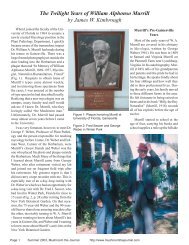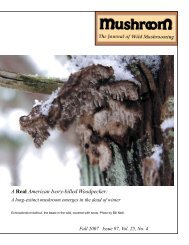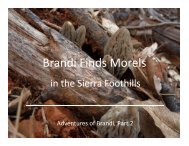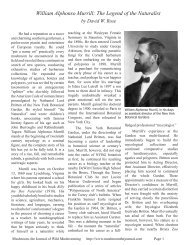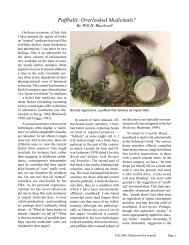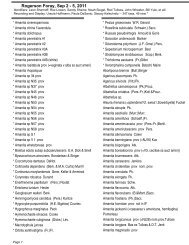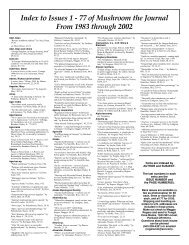Connecticut-Westchester Mycological Association - Mushroom, the ...
Connecticut-Westchester Mycological Association - Mushroom, the ...
Connecticut-Westchester Mycological Association - Mushroom, the ...
Create successful ePaper yourself
Turn your PDF publications into a flip-book with our unique Google optimized e-Paper software.
Spores Illustrated Spring 2010<br />
SPRING<br />
2010<br />
<strong>Connecticut</strong>-<strong>Westchester</strong> <strong>Mycological</strong> <strong>Association</strong><br />
President: Dianna Smith Diannasmith@optonline.net<br />
Membership: Beverly Leffers (718)636-6348 Morrsarian@juno.com<br />
Treasurer: Donald Shernoff (914)761-033 Donshernoff@yahoo.com<br />
Editor: Rena Wertzer (914)472-3575 Renawertzer@hotmail.com<br />
Webmaster: Ursula Hoffmann (212) 288-5460<br />
Ursula.hoffmann@lehman.cuny.edu<br />
COMA SPRING MEETINGS<br />
Meetings at <strong>the</strong> Friends' Meeting House in Purchase, 7:30 p.m. are open to <strong>the</strong> public. Bring<br />
samples of your fungi finds to all of our evening programs and we will help you with identification.<br />
Wednesday, April 28; 7:30 pm<br />
The Genus Leccinum – Bill Bakaitis, writer, mycology educator, and past president of <strong>the</strong><br />
Mid-Hudson <strong>Mycological</strong> <strong>Association</strong>, will lecture on Leccinum, a popular genus of boletes. In<br />
this illustrated talk, Bill will review <strong>the</strong> macroscopic characters of Leccinum species commonly<br />
found in <strong>the</strong> Nor<strong>the</strong>ast and provide a flow chart to key out <strong>the</strong> genus. He will also discuss a<br />
recent case of poisoning caused by a species of Leccinum.<br />
Tuesday, May 25; 7:30 pm<br />
The Genus Psilocybe – Gary Lincoff, author of <strong>the</strong> popular Audubon Society Field Guide to<br />
North American <strong>Mushroom</strong>s, will discuss some peculiarities of Psilocybe, a purple-spored<br />
mushroom genus with an out-sized reputation. Gary’s exploration of Psilocybe in this talk will<br />
delve into <strong>the</strong> taxonomy, ethnomycology, and <strong>the</strong> history of spiritual and recreational uses of<br />
Psilocybe in American culture and around <strong>the</strong> world.<br />
Thursday, June 24; 7:30 pm<br />
What’s in a Name? – Do scientific names give you a headache? Do you lie awake at night<br />
wondering why <strong>the</strong> mycologists are forever changing <strong>the</strong> names of your favorite mushrooms?<br />
COMA’s David Rose will take <strong>the</strong> perplexity out of scientific nomenclature and show how to<br />
make this subject fun. This illustrated talk will analyze <strong>the</strong> names of common mushrooms that<br />
we find on our walks and review <strong>the</strong> history and current state of taxonomy of <strong>the</strong> Kingdom<br />
Fungi.<br />
Directions to Friends’ Purchase Meeting House:<br />
From I-684 - Take Exit 2 to stoplight at Route 120 (Purchase St.). Turn right and go 1 mile to a sharp left turn<br />
(following Route 120). The Friends' Meeting House is on <strong>the</strong> left at <strong>the</strong> corner.<br />
From I-287 - Take Exit 8 (westbound) or Exit 8E (eastbound) and follow signs for Anderson Hill Road and<br />
SUNY Purchase. Take Anderson Hill Road to Route 120, turn left and go about 2 miles to <strong>the</strong> intersection<br />
with Lake Street. The Friends' Meeting House is on <strong>the</strong> right just before <strong>the</strong> intersection.<br />
COMA Page 1
Spores Illustrated Spring 2010<br />
How to Improve Your Chances of Finding Morels<br />
by JJ Murphy<br />
On <strong>the</strong> way back from our COMA walk, I noticed most of <strong>the</strong> group was nowhere in sight. A few minutes later<br />
two of our members walked up behind me and said, “They found a patch of morels. It’s like a feeding frenzy.”<br />
The trail we took was easy to follow, so I knew <strong>the</strong> group would eventually catch up. But I had to wonder.<br />
What is it about morels that turns normally calm people into frenzied competitors?<br />
The advice I’m about to share applies to every plant you remove from <strong>the</strong> forest. When heading out to <strong>the</strong> field,<br />
I always carry an extra container of sunflower seeds or granola, which I keep in <strong>the</strong> same pocket as my<br />
mushroom knife. Before I even spot my first mushroom, I take a minute to scatter some seeds or granola. The<br />
way I see it, if I’m removing a source of food from <strong>the</strong> forest, I should put something back. This may sound farfetched,<br />
but every time I do this, I find a mushroom. Once I find a mushroom, I place a few seeds or a pinch of<br />
granola on <strong>the</strong> spot where I harvested. Needless to say, I keep finding morels.<br />
I leave <strong>the</strong> smallest morels to grow and spread <strong>the</strong>ir spores. I take <strong>the</strong> largest morels I can find. Fungi are <strong>the</strong><br />
only exception to my ten percent rule. I typically do not harvest more than ten percent of any wild plant I find.<br />
We tend to forget that <strong>the</strong> forests we visit are <strong>the</strong> homes of a wide range of wildlife. I’d be pretty upset if<br />
someone came to my house for a couple of hours, cleaned out my refrigerator and left. It’s important to think<br />
about stewardship. You want to be sure not to ravage and destroy <strong>the</strong> habitat, not only for <strong>the</strong> sake of <strong>the</strong><br />
wildlife, but for sustainability.<br />
The payoff has been that I find increasing numbers of morels every year. I spend time not just<br />
foraging, but sitting on a rock or downed log and really looking at <strong>the</strong> condition of <strong>the</strong> forest floor, <strong>the</strong><br />
trees, evidence of animal trails. Instead of tossing leaves around and covering up <strong>the</strong> morels, I find<br />
that sitting quietly and really looking, studying <strong>the</strong> area from different vantage points results in larger<br />
yields. It’s great to find morels in areas where <strong>the</strong>y are known to have been found in <strong>the</strong> past. But my<br />
goal is to develop <strong>the</strong> ability to “read” <strong>the</strong> earth and notice conditions that would be likely to result in<br />
finding <strong>the</strong>se desirable mushrooms wherever I hike.<br />
---<br />
JJ Murphy is a freelance nature writer, photographer, forager, and aspiring mycologist giving<br />
nature a voice at www.WriterByNature.com.<br />
Morel Art JJ Murphy<br />
COMA Page 2
Spores Illustrated<br />
Review by David Rose<br />
Spring 2010<br />
<strong>Mushroom</strong> World, by Steve Roberts (2009), CD. A collection of original mushroom<br />
songs for serious (and not so serious) <strong>Mushroom</strong> Hunters.<br />
Exuberance is beauty said William Blake, and this charming collection of folk songs<br />
about mushrooms has both in full measure. Steve Roberts is <strong>the</strong> exuberant singer, guitarist,<br />
harmonica player, and composer. A Tennessee resident, his rhapsody on <strong>the</strong> ways of<br />
mushroom hunting captures <strong>the</strong> intimate pleasures of <strong>the</strong> moment and <strong>the</strong> full beauty of <strong>the</strong><br />
seasons. The title song of <strong>Mushroom</strong> World, rooted in plaintive melody, is a down-home<br />
tribute to autumn where <strong>the</strong> circumambient tone of falling leaves, a hint of frost in <strong>the</strong> air, and<br />
fungal earthiness provoke memories of good times in <strong>the</strong> woods on <strong>the</strong> mushroom trail.<br />
<strong>Mushroom</strong>s are <strong>the</strong> common focus of all ten songs here, and <strong>the</strong> entire effect is to redirect<br />
<strong>the</strong> listener to that “o<strong>the</strong>r world” where <strong>the</strong> mushrooms are calling us. That o<strong>the</strong>r world may<br />
be a favorite bolete hunting spot, or it might just be a state of mind. In any case, here is a set<br />
of tunes whose populist vision of mushrooming is informed by long experience in mycology<br />
and music, and <strong>the</strong> result is utterly splendid.<br />
Anyone who has had <strong>the</strong> great good fortune of hearing Steve Roberts perform at a<br />
foray knows firsthand his spirited musicianship. Like o<strong>the</strong>r singer/songwriters who have<br />
worked in <strong>the</strong> folk arena, he has covered a wide range of subjects from <strong>the</strong> meaning of home<br />
and family to political critique. Steve is a bluesy improviser and knowledgeable chronicler of<br />
song. In <strong>Mushroom</strong> World one hears elements of Bob Dylan, John Prine, James Taylor, and<br />
Neil Young, but <strong>the</strong>se influences are all subtly intimated in eclectic settings. Steve has<br />
assimilated everything from Johnny Cash to <strong>the</strong> Feelies and made it his own – and he added<br />
<strong>the</strong> mushrooms! His accompanists, who include his wife Toni and <strong>the</strong>ir daughter Addie,<br />
achieve a perfect balance in a production whose clarity is sustained throughout.<br />
Steve Roberts knows his mushrooms; in <strong>Mushroom</strong> World he proves that he also<br />
knows <strong>the</strong> kinds of folk who are crazy about <strong>the</strong>m: myco-gypsies, Johnny Appleseed types,<br />
cock-eyed obsessives with toadstools in <strong>the</strong>ir beards. Where else will one hear a musical<br />
reference to Vibrissea truncorum (“I even found one growin’ in a stream”) but in <strong>the</strong> songs of<br />
an experienced mushroomer? The cautionary tale of Amanita virosa (“The Angel”) is catchy<br />
and compelling (“it’ll fry your liver!”), and “The Old <strong>Mushroom</strong> Road” finds violin and<br />
harmonica in delicate counterpoint to piano seeking out that melancholy moment that, deep<br />
down inside, all of us surely know. Here are exuberant songs that are kid-friendly, funny, and<br />
wholly original – a toe-tapping elegy to your favorite patch of mushrooms. <strong>Mushroom</strong> World is<br />
just what <strong>the</strong> world has been waiting for! The mushrooms rule and <strong>the</strong> music rocks!<br />
Find out more about <strong>Mushroom</strong> World at www.myspace.com/musicbysteveroberts and via<br />
email at wildmushroomman@netscape.net.<br />
----------------------------------------------------------------------------------------------------------------------------<br />
Note to COMA members: This issue of Spores Illustrated is being sent in hard copies only<br />
because of <strong>the</strong> inclusion of <strong>the</strong> walk schedule and <strong>the</strong> directions to <strong>the</strong> walks. For <strong>the</strong><br />
summer issue we will resume <strong>the</strong> electronic issues for those who prefer <strong>the</strong>m.<br />
COMA Page 3
Spores Illustrated Spring 2010<br />
NAMA 2010 - 50th Anniversary Foray<br />
August 12-15, 2010, at <strong>the</strong> YMCA Snow Mountain Ranch, Winter Park, Colorado<br />
Information at NAMA and CMS (Colorado <strong>Mycological</strong> Society)<br />
Co-Chief Identifiers: Cathy Cripps, Vera Evenson<br />
Faculty: Scott Bates, Denis Benjamin, MD, Michael Beug, Roy Halling, Rick Kerrigan,<br />
Michael Kuo, Brandon Ma<strong>the</strong>ny, Michelle Seidl , Jack States, Walt Sundberg, Rytas Vilgalys,<br />
Tom Volk, Nancy Weber<br />
The Colorado <strong>Mycological</strong> Society is delighted to welcome NAMA to <strong>the</strong> Centennial State<br />
for NAMA's 50th Anniversary Foray, August 12-15, 2010. The foray will be held at <strong>the</strong> same<br />
location as NAMA's memorable 1983 foray, YMCA of <strong>the</strong> Rockies Snow Mountain<br />
Ranch, 14 miles from Winter Park, high on <strong>the</strong> western slope of <strong>the</strong> Continental Divide at<br />
8,700 feet. Nearby Rocky Mountain National Park is celebrating its 95th Anniversary this<br />
year, and at least one of our forays is planned to study fungi in that area.<br />
If you need any more information, please reply. We hope to see you in August!<br />
Linnea Gillman<br />
Colorado <strong>Mycological</strong> Society<br />
NAMA 2010<br />
See NAMA website for information and registration forms:<br />
http://www.namyco.org/events/index2010.html<br />
COMA<br />
8 Coralyn Road<br />
Scarsdale, NY 10583<br />
COMA Page 4



